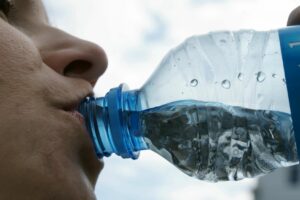My doctor referred me for a Videofluoroscopic Swallowing Study (VFSS), what is that?
There are different tests that look at how well you swallow food and liquid. Speech-language pathologists, or SLPs, perform these tests.
You may have already had a swallowing test with an SLP. You may have been tested in the SLP’s office, in your home, or in the hospital. The SLP may have checked how well you move your mouth muscles and how clearly you talk. You may have tried different foods and liquids.
Sometimes, the SLP needs more information about how you swallow. You may need another swallowing test—this time in the radiology, or x-ray, department.
You may hear different names for this test, such as:
- videofluoroscopic swallowing study, or videofluoroscopy
- modified barium swallow, or MBS
- esophagram
- cookie swallow
The American Speech-Language-Hearing Association, or ASHA, uses the term videofluoroscopic swallowing study, or VFSS.
About the VFSS
This test helps the SLP see what happens in your mouth and throat when you swallow. The VFSS lets the SLP see:
- if food goes into your airway instead of your stomach, called aspiration
- which parts of your mouth and throat may not work well
- what kinds of food are safest for you to swallow
- if certain positions or strategies help you swallow better
Having a VFSS
This study happens in the radiology, or x-ray, department. You will meet the SLP there. There may also be a doctor there, called a radiologist. A radiology technician will be there to help you get ready and set up the equipment.
You will sit or stand next to an x-ray machine. Your SLP will give you different foods and drinks mixed with barium. The barium makes the food and liquid show up on the x-ray. Barium will not hurt you or stay in your body for too long. The x-ray machine is turned on only while you swallow, so you will not get too much radiation.
You may try soft and hard foods, or thin and thick liquids. You may take small or large bites and sips. You may need to move your head in different positions. You may also try things like swallowing hard. The SLP may record the test and watch it again later.
You should not have this test done if you think you may be pregnant. It is not safe to have x-rays while pregnant.
After the VFSS
Your SLP and doctor will talk about what they saw during the study. The SLP may show you the video of the test so you can see what happens yourself. Your SLP will use the test results to decide what treatment will help your swallowing. You and the SLP will discuss what foods and liquids are safest, and how to eat them. You may start swallowing therapy soon after the study.
Call our Rehabilitation Department’s Speech/Language Pathologist, Joann Anderson today at 507-831-0634 for more information!
Blog Written By: Joann Anderson, Speech Language Pathologist
